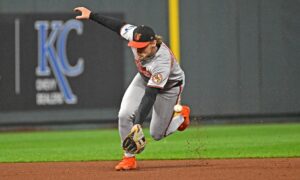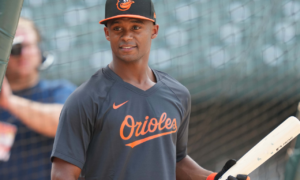SCROLL DOWN TO READ ARTICLE
It’s no surprise that the Orioles were active in Thursday’s Rule 5 draft. Since Dan Duquette took the reins as executive vice president in 2011, the Orioles have made at least one selection in the Rule 5 draft every year.
What was surprising, though, was that the Orioles selected three players Thursday — the most they’ve ever picked in a single draft under Duquette. All three were pitchers, demonstrating the club’s need for pitching depth at the major league level.
Two of the Orioles’ selections were plucked from the New York Yankees’ organization: lefty Nestor Cortes and right-hander Jose Mesa. The Orioles raided the Chicago Cubs for their other pick, righty Pedro Araujo.
Cortes, who turned 23 on Sunday, was a 36th-round draft pick by the Yankees in 2013. In five seasons in the minors, he’s 25-14 with a 2.08 ERA in 84 games (40 starts). He split the 2017 season between Double-A Trenton and Triple-A Scranton/Wilkes-Barre, going 7-4 with a 2.06 ERA. In his minor league career, the 5-foot-11 Cortes has averaged 9.5 strikeouts per nine innings and just 0.5 homers per nine.
CONTINUE READING BELOW
“Nestor Cortes is a very versatile left-handed pitcher,” Duquette told reporters at the completion of the Rule 5 draft during the annual winter meetings. “He’s got good breaking stuff, excellent control, very good competitor. His role model is Gio Gonzalez and he’s from South Florida, a very competitive environment. He’s advanced. He pitched well at Double-A, he’s pitched well at Triple-A and we think he may be able to compete as a spot starter with the big league club.”
Mesa, 24, is the son of former Orioles pitcher Jose Mesa, a 19-year major league veteran. Like his father, the younger Mesa has worked mostly as a reliever, though he made eight starts among his 29 appearances in 2017. Mesa hasn’t pitched higher than the Double-A level, but he had great success in a brief stint for Trenton, going 4-0 with a 0.79 ERA in eight games (five starts).
“Jose Mesa Jr., he looks just like his daddy and he’s got the same kind of build,” Duquette said. “Very similar delivery. It looks like a flashback to his dad when he was a closer with the Indians. He’s got a good curve, good control, nice composure and a good assortment of pitches.”
Araujo, 23, is perhaps the most raw of the bunch. He’s pitched in just one game above Single-A ball. He spent most of 2017 at the Cubs’ Single-A affiliate, Myrtle Beach, where he was 6-1 with a 1.81 ERA and 11.6 strikeouts per nine.
“We saw him very good in the Arizona Fall League. [Orioles scout] Dave Engle recommended him. He throws three good pitches, good control. He’s also gotten very good results over his professional career and he’ll give us an option to compete for the bullpen.”
CONTINUE READING BELOW
Players drafted in the Rule 5 must stay on the major league roster for the entire season or else be offered back to their former teams. And obviously, it would be extremely unlikely — if not impossible — for the Orioles to keep all three Rule 5 picks on the major league roster all season.
Of the three, Cortes seems the most likely to stick. He gives the Orioles a lefty candidate for the starting rotation that they’ve been seeking, though he’s more likely bullpen-bound. He also has more experience in the upper minors than Mesa and Araujo, which could make him a bit more prepared to adapt to a major league role.
Still, the Orioles don’t have much to lose by adding three young arms to the organization, even if just temporarily, and evaluating them at spring training.
“We like all three pitchers we took to the major league club and feel they have a legitimate shot to compete in the spring,” Duquette said.
With the additions of Cortes, Mesa and Araujo, the Orioles have acquired 11 players in the Rule 5 draft in Duquette’s seven years. Here’s a look at their previous Rule 5 picks of the Duquette era.
2011: IF Ryan Flaherty (selected from Chicago Cubs)
Duquette’s first Rule 5 draft pick with the Orioles was, to this point, his most successful. Flaherty wasn’t exactly a star in Baltimore, but he was an ever-present bench player for parts of six years before hitting the free agent market this winter. When the Orioles selected him, he was a former 41st overall pick by the Cubs out of Vanderbilt who had put up stellar offensive numbers at Double-A Tennessee in 2011. “Ryan is a high draft pick from an excellent college program, and we really like his bat,” Duquette said at the time.
Ironically, Flaherty stuck around with the Orioles not because of his bat but because of his defensive versatility. During his Baltimore career, he started at least 10 games at every position except catcher and center field, showing a capable glove at most of them. His offense, though, never developed. He batted .215 with a .639 OPS in 452 games. He popped 35 home runs — plus two postseason homers — but amassed just a .284 OBP, which held him back from becoming a full-time player.
2012: LHP T.J. McFarland (selected from Cleveland Indians)
The Orioles thought they might have landed a diamond in the rough when they plucked McFarland, then 23, out of the Cleveland system. He was coming off a 16-8 season with a 4.03 ERA for the Indians’ Double-A and Triple-A affiliates. “He’s got a good sinker, he keeps the ball down, he’s got a good changeup and he throws strikes in the bottom of the strike zone,” Duquette said. “We know he has a knack for winning games, and hopefully that knack will translate to the major leagues.”
McFarland didn’t quite pile up the wins in Baltimore, going 12-7 with a 4.27 ERA over his four-year Orioles’ career. Although he’d been almost exclusively a starter in the minors, he wasn’t cut out for that role in the bigs, making just two starts for the club. Still, McFarland soaked up some useful innings out of the bullpen, with his best season coming in 2014 when he posted a 2.76 ERA in 37 games. The Orioles cut him loose after an injury-marred 2016 season. He spent 2017 with the Arizona Diamondbacks, going 4-5 with a 5.33 ERA in 43 games, and he re-signed with that club this winter.
CONTINUE READING BELOW
2013: IF Michael Almanzar (selected from Boston Red Sox)
Almanzar is one of only two Rule 5 picks in the Duquette era who never made an appearance with the Orioles. He’d had an unremarkable minor league career before a pair of decent offensive seasons in 2012 and 2013 convinced the Orioles to take a shot with him. But the club wasn’t impressed offensively or defensively by Almanzar at 2014 spring training. After a long DL stint with left patellar tendinitis, Almanzar was sent back to the Red Sox.
The Orioles re-acquired him later in 2014 in a trade that also brought veteran infielder Kelly Johnson to Baltimore. Almanzar spent parts of three years in the Orioles’ minors but didn’t play well enough to earn a call-up. He split 2017 between the Detroit Tigers’ and Washington Nationals’ organizations.
2014: RHPs Logan Verrett (selected from New York Mets) and Jason Garcia (acquired from Houston Astros after being selected from Red Sox)
The Orioles loaded up on Rule 5 pitchers this year, taking Verrett with their own selection and trading with the Astros for Garcia. They went into 2015 spring training figuring they would have room for only one on the roster. Verrett was considered the more major league ready of the two; he’d spent the entire 2014 season at Triple-A Las Vegas, going 11-5 with a 4.33 ERA. Garcia was more raw — he’d never pitched above the Single-A level — but carried a higher upside.
As camp wound down, the Orioles opted for the more electric arm, losing Verrett on waivers while hanging onto Garcia, who flashed a fastball that could reach the upper 90s. Garcia had caught the Orioles’ attention while pitching for the Red Sox’ instructional league team the previous season. Garcia, though, didn’t much resemble that flamethrowing minor leaguer during his one season with the Orioles. He struggled with his control, walking 17 batters in 21 games, and spent nearly three months on the DL with right shoulder tendinitis.
Garcia hasn’t made a major league appearance since 2015, spending the last three years at Double-A Bowie, where he was 13-16 with a 4.88 ERA. He’s now a minor league free agent. Meanwhile, Verrett eventually made his way back to the Orioles in a 2016 trade, and pitched four games for the club in 2017. This winter, he signed with the NC Dinos of the Korean Baseball Organization.
2015: OF Joey Rickard (selected from Tampa Bay Rays)
The Orioles were excited about their selection of Rickard, who they thought could bring much-needed speed and on-base abilities to the lineup. The 24-year-old was coming off a 2015 season in which he’d batted .321 with a .427 OBP across three minor-league levels, including .360/.437 in 29 games for Triple-A Durham. “He’s an excellent contact hitter, he can steal a base and he’s a good defensive player,” Duquette said. “We think he’ll give us some depth and on-base capabilities.”
The pick looked brilliant at first when Rickard took spring training by storm, batting .397 with a team-best 25 hits, to win the starting left field job out of camp. But after Rickard started the season on a 21-for-60 hot streak, the league caught up to him. He finished the year with a .268 average and .696 OPS and also struggled with his routes in the outfield. In 2017, Rickard’s defense improved but his offense slipped further (.241 average, .621 OPS). His on-base skills from the minors have yet to translate to the bigs, and he’s probably not much more than a fourth or fifth outfielder at this point.
2016: OFs Aneury Tavarez (selected from Red Sox) and Anthony Santander (selected from Indians)
For the second time in a three-year span, the Orioles carried two Rule 5 picks into spring training, knowing that they’d only be able to carry one, at most. As with the Verrett/Garcia competition, it was a battle between one lower-ceiling but closer to the majors product (Tavarez) and one low-minors prospect with more upside (Santander).
Tavarez was a speedster who had 90 career steals in the minors, but the Orioles weren’t impressed with his defense at spring training and sent him back to the Red Sox. They preferred the offensive potential of Santander, who’d put up enormous numbers at High-A Lynchburg (.290 average, .862 OPS, 20 homers and 95 RBIs). “He was the best offensive player in the Carolina League,” Duquette said. “We like his capability to hit in the big leagues, to hit from both sides of the plate for power.”
Santander’s offseason shoulder surgery added a complication to the process. Because of his four and a half month stint on the DL, he didn’t accumulate enough time on the active roster to shed his Rule 5 status. He’ll need to spend the first 44 days on the Orioles’ 2018 roster before the club can option him to the minors.
9 Comments
You must be logged in to post a comment Login or Register Here
Leave a Reply
You must be logged in to post a comment.










